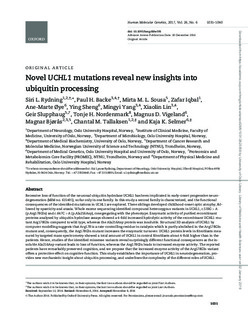| dc.description.abstract | Recessive loss of function of the neuronal ubiquitin hydrolase UCHL1 has been implicated in early-onset progressive neurodegeneration (MIM no. 615491), so far only in one family. In this study a second family is characterized, and the functional consequences of the identified mutations in UCHL1 are explored. Three siblings developed childhood-onset optic atrophy, followed by spasticity and ataxia. Whole exome sequencing identified compound heterozygous variants in UCHL1, c.533G > A (p.Arg178Gln) and c.647C > A (p.Ala216Asp), cosegregating with the phenotype. Enzymatic activity of purified recombinant proteins analysed by ubiquitin hydrolase assays showed a 4-fold increased hydrolytic activity of the recombinant UCHL1 mutant Arg178Gln compared to wild type, whereas the Ala216Asp protein was insoluble. Structural 3D analysis of UCHL1 by computer modelling suggests that Arg178 is a rate-controlling residue in catalysis which is partly abolished in the Arg178Gln mutant and, consequently, the Arg178Gln mutant increases the enzymatic turnover. UCHL1 protein levels in fibroblasts measured by targeted mass spectrometry showed a total amount of UCHL1 in control fibroblasts about 4-fold higher than in the patients. Hence, studies of the identified missense variants reveal surprisingly different functional consequences as the insoluble Ala216Asp variant leads to loss of function, whereas the Arg178Gln leads to increased enzyme activity. The reported patients have remarkably preserved cognition, and we propose that the increased enzyme activity of the Arg178Gln variant offers a protective effect on cognitive function. This study establishes the importance of UCHL1 in neurodegeneration, provides new mechanistic insight about ubiquitin processing, and underlines the complexity of the different roles of UCHL1. | nb_NO |
